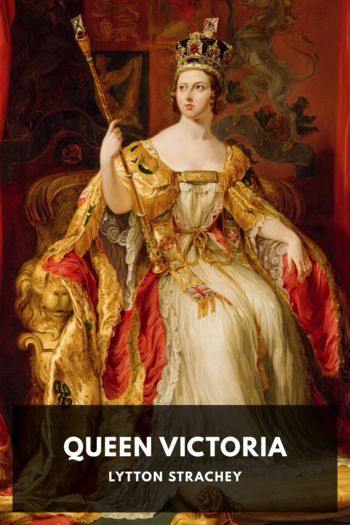Queen Victoria Lytton Strachey (a book to read .txt) 📖

- Author: Lytton Strachey
Book online «Queen Victoria Lytton Strachey (a book to read .txt) 📖». Author Lytton Strachey
Mr. Martin was rewarded by a knighthood; and yet it was sadly evident that neither Sir Theodore nor his predecessors had achieved the purpose which the Queen had in view. Perhaps she was unfortunate in her coadjutors, but, in reality, the responsibility for the failure must lie with Victoria herself. Sir Theodore and the others faithfully carried out the task which she had set them—faithfully put before the public the very image of Albert that filled her own mind. The fatal drawback was that the public did not find that image attractive. Victoria’s emotional nature, far more remarkable for vigour than for subtlety, rejecting utterly the qualifications which perspicuity, or humour, might suggest, could be satisfied with nothing but the absolute and the categorical. When she disliked she did so with an unequivocal emphasis which swept the object of her repugnance at once and finally outside the pale of consideration; and her feelings of affection were equally unmitigated. In the case of Albert her passion for superlatives reached its height. To have conceived of him as anything short of perfect—perfect in virtue, in wisdom, in beauty, in all the glories and graces of man—would have been an unthinkable blasphemy: perfect he was, and perfect he must be shown to have been. And so, Sir Arthur, Sir Theodore, and the General painted him. In the circumstances, and under such supervision, to have done anything else would have required talents considerably more distinguished than any that those gentlemen possessed. But that was not all. By a curious mischance Victoria was also able to press into her service another writer, the distinction of whose talents was this time beyond a doubt. The Poet Laureate, adopting, either from complaisance or conviction, the tone of his sovereign, joined in the chorus, and endowed the royal formula with the magical resonance of verse. This settled the matter. Henceforward it was impossible to forget that Albert had worn the white flower of a blameless life.
The result was doubly unfortunate. Victoria, disappointed and chagrined, bore a grudge against her people for their refusal, in spite of all her efforts, to rate her husband at his true worth. She did not understand that the picture of an embodied perfection is distasteful to the majority of mankind. The cause of this is not so much an envy of the perfect being as a suspicion that he must be inhuman; and thus it happened that the public, when it saw displayed for its admiration a figure resembling the sugary hero of a moral storybook rather than a fellow man of flesh and blood, turned away with a shrug, a smile, and a flippant ejaculation. But in this the public was the loser as well as Victoria. For in truth Albert was a far more interesting personage than the public dreamed. By a curious irony an impeccable waxwork had been fixed by the Queen’s love in the popular imagination, while the creature whom it represented—the real creature, so full of energy and stress and torment, so mysterious and so unhappy, and so fallible and so very human—had altogether disappeared.
IVWords and books may be ambiguous memorials; but who can misinterpret the visible solidity of bronze and stone? At Frogmore, near Windsor, where her mother was buried, Victoria constructed, at the cost of £200,000, a vast and elaborate mausoleum for herself and her husband. But that was a private and domestic monument, and the Queen desired that wherever her subjects might be gathered together they should be reminded of the Prince. Her desire was gratified; all over the country—at Aberdeen, at Perth, and at Wolverhampton—statues of the Prince were erected; and the Queen, making an exception to her rule of retirement, unveiled them herself. Nor did the capital lag behind. A month after the Prince’s death a meeting was called together at the Mansion House to discuss schemes for honouring his memory. Opinions, however, were divided upon the subject. Was a statue or an institution to be preferred? Meanwhile a subscription was opened; an influential committee was appointed, and the Queen was consulted as to her wishes in the matter. Her Majesty replied that she would prefer a granite obelisk, with sculptures at the base, to an institution. But the committee hesitated: an obelisk, to be worthy of the name, must clearly be a monolith; and where was the quarry in England capable of furnishing a granite block of the required size? It was true that there was granite in Russian Finland; but the committee were advised that it was not adapted to resist exposure to the open air. On the whole, therefore, they suggested that a Memorial Hall should be erected, together with a statue of the Prince. Her Majesty assented; but then another difficulty arose. It was found that not more than £60,000 had been subscribed—a sum insufficient to defray the double expense. The Hall, therefore, was abandoned; a statue alone was to be erected; and certain eminent architects were asked to prepare designs. Eventually the committee had at their disposal a total sum of £120,000, since the public subscribed another £10,000, while £50,000 was voted by Parliament. Some years later a joint stock company was formed and built, as a private speculation, the Albert Hall.319
The architect whose design was selected, both by the committee and by the Queen, was Mr. Gilbert Scott, whose industry, conscientiousness, and genuine





Comments (0)